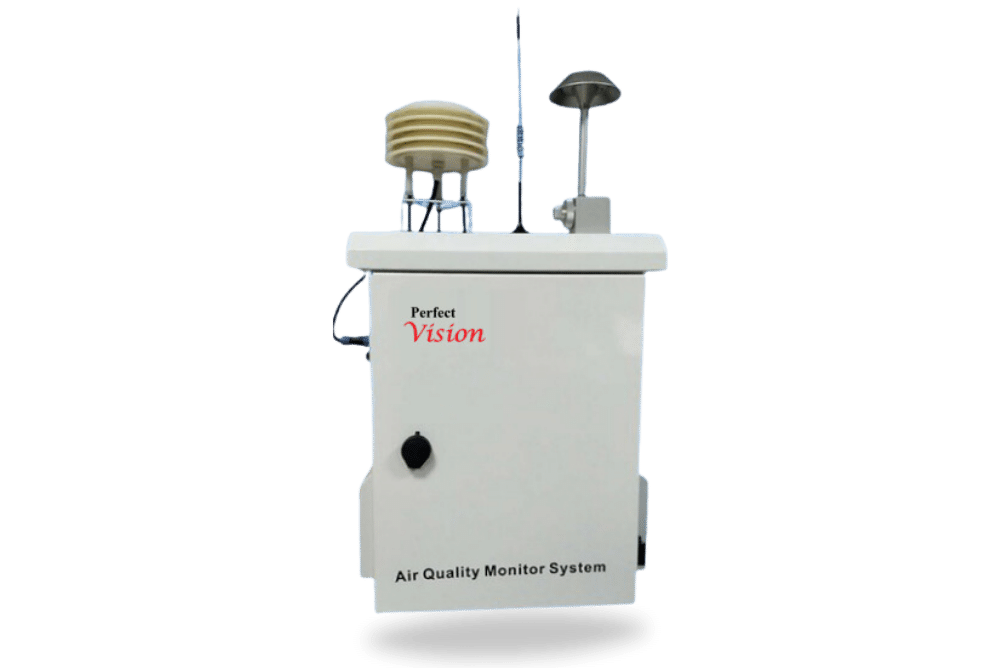Air Quality Monitoring Device
An Air Quality Monitoring System (AQMS) is a technology used to monitor and assess air quality in a particular environment. It typically measures various pollutants and other factors that affect air quality, such as particulate matter, gases like carbon monoxide and ozone, humidity, temperature, and air pressure. The data collected by the AQMS helps authorities and researchers understand the level of pollution in the air and its potential impact on public health and the environment.
With Perfect Vision’s Air Quality Monitoring System, individuals can maintain their safety and well-being by consistently tracking the air quality in the vicinity where they live or work. By staying vigilant and proactive with the help of our AQMS, people can better protect themselves from potential health hazards associated with poor air quality.

Features of Air Quality Monitoring System
Measures the presence of this toxic gas, which can be harmful to human health when inhaled in high concentrations.
Detects tiny particles suspended in the air, including dust, soot, and pollen, which can impact air quality and respiratory health.
Monitors levels of ozone (O3), nitrogen dioxide (NO2), and sulphur dioxide (SO2), which are common air pollutants with various adverse effects on health and the environment.
Determines the amount of moisture present in the air, influencing comfort levels and the formation of pollutants like mold.
Records the ambient temperature, aiding in understanding weather patterns and their influence on air quality.
Tracks the level of ambient noise pollution, which can impact well-being and contribute to environmental disturbances.
Measures atmospheric pressure, providing insights into weather changes and their effects on air quality.
Indicates the speed at which air is moving, influencing the dispersion of pollutants and the transport of airborne contaminants.
Determines the direction from which the wind is blowing, helping to identify pollution sources and their impact on different areas.
Activates alerts or notifications when air quality parameters exceed predefined thresholds, ensuring timely responses to potential health risks.
Allows for remote control and adjustment of monitoring parameters, enhancing flexibility and ease of use in various monitoring scenarios.
Technical Parameter
| Items | Description | Specification |
|---|---|---|
| Particle Module | Monitor method | Continuously, automatically and real time |
| Working principle | Light scattering technique | |
| Measurement data | PM2.5, PM 10, TSP | |
| Measuring range | 0~1000ug/m3 (Range can be extended) | |
| Response time | ≤60s | |
| Resolution | 1ug/m3 | |
| Measurement accuracy / reproducibility | >100ug/m3, +20% | |
| Parallelism | 10% | |
| Sampling flow | 1.3L/min, +0.15 | |
| Sampling time | Adjustable (Default is 5 minutes) | |
| Dehumidification | With the automatic dehumidification function module | |
| Cutter | Cyclone cutter | |
| Fault alarm | Real-time display the fault alarm | |
| Gas Module | Monitor method | Continuously, automatically and real time |
| Working Principle | Electrochemical sensor, infrared sensor, PID sensor | |
| Gas Monitoring | SO2, CO, NO2, O3, etc | |
| SO2 | Measuring range: 0~1000ppb Resolution:1ppb Response time: Less than 45s |
|
| CO | Measuring range: 0~200ppb Resolution:0.1ppm Response time: Less than 45s |
|
| NO2 | Measuring range: 0~1000ppb Resolution: 1ppm Response time: Less than 45s |
|
| O3 | Measuring range: 0~1000ppb Resolution: 1ppm Response time: Less than 45s |
|
| Meteorological Parameters |
Temperature: Measuring range: ~30°C-60°C, Precision: +0.3°C (20°C) Humidity: Measuring range: 0~95%RH, Precision: +5°%RH Wind direction: Measuring range: 0-360°, Precision: +5° 0.1m/s Wind speed: Measuring range: 0-60m/s, Precision: +0.3 m/s Barometric pressure: Measuring range: 600~1110hpa, Precision: +0.5hpa |
|
| Noise Meter |
Measuring range: 30~130dB(A) Sampling frequency: 1s Dynamic analysis range: ≥100db(A) Frequency weighting: A, C, Z Time weighting: F, S |
|
System Specification
| Category | Description |
|---|---|
| Data Efficient Transmission Rate | ≥95% |
| Remote Control | Support for remote setting |
| Interface | RS485 port, Network port |
| Transmission Network | Automatically and real-time upload data, optional 4G/GPRS |
| Box Material | Q235 spray, Stainless box optional |
| Scaffold Material | Q235 |
| Scaffold Height | Standard height is 4.5m, Flange connection (1m fixed underground, 2*1.5m+1*0.5m) |
| Lightning Arrester | Length 1.5~2m, Q235 Galvanized material |
| Working Environment |
Temperature: -20 ~50°C Humidity: 5%RH~95%RH Pressure: 65~108Kpa |
| Protection Grade | IP55 |
| Power Supply | AC220V/50Hz/Solar power(optional) |
Understanding the Functionality of Air Quality Monitoring System
An AQMS, or Air Quality Monitoring System, functions through a network of sensors strategically positioned to continuously measure pollutants and environmental parameters in the air. These sensors gather data on various factors including carbon monoxide, particulate matter, ozone, humidity, temperature, wind speed, and direction. This collected data is then transmitted to a central monitoring station or processing unit in real-time, where it undergoes analysis using advanced algorithms to calculate air quality indices and pollutant concentrations.
Once analysed, the results are made accessible to authorities, researchers, and the public through user-friendly interfaces such as monitoring dashboards or online platforms. If pollution levels surpass predefined thresholds, the AQMS can issue alerts or notifications to prompt appropriate actions aimed at mitigating pollution and safeguarding public health. Air Quality Monitoring Device plays a crucial role in monitoring and managing air quality, informing decision-making processes, and fostering environmental sustainability.
Contact our experts now !
Let’s discuss how our solutions can make your workplace safer and more secure. Your safety is our priority.

